Toyota's Strategic Analysis: Macro Environment & Internal Factors
VerifiedAdded on 2021/06/14
|23
|5887
|257
Report
AI Summary
This assignment provides a detailed analysis of Toyota Motor Corporation's business strategy, focusing on the impact and influence of the macro environment and internal capabilities. It begins with a brief profile of Toyota, including its mission, vision, and objectives. The report then applies various frameworks such as PESTLE, Five Forces, Stakeholder Analysis, BCG Matrix, and Ansoff’s Growth Vector Matrix to analyze the macro environment and its influence on Toyota's strategies. Furthermore, the assignment assesses Toyota's internal environment using Value Chain Analysis and the VRIO framework to evaluate its strategic capabilities. The analysis covers Toyota's approach to achieving business objectives, strategic intent, and different strategic directions, including market penetration and product development. The report concludes by summarizing key findings and their implications for Toyota's strategic growth management. This document, contributed by a student, is available on Desklib, a platform offering AI-based study tools and solved assignments.
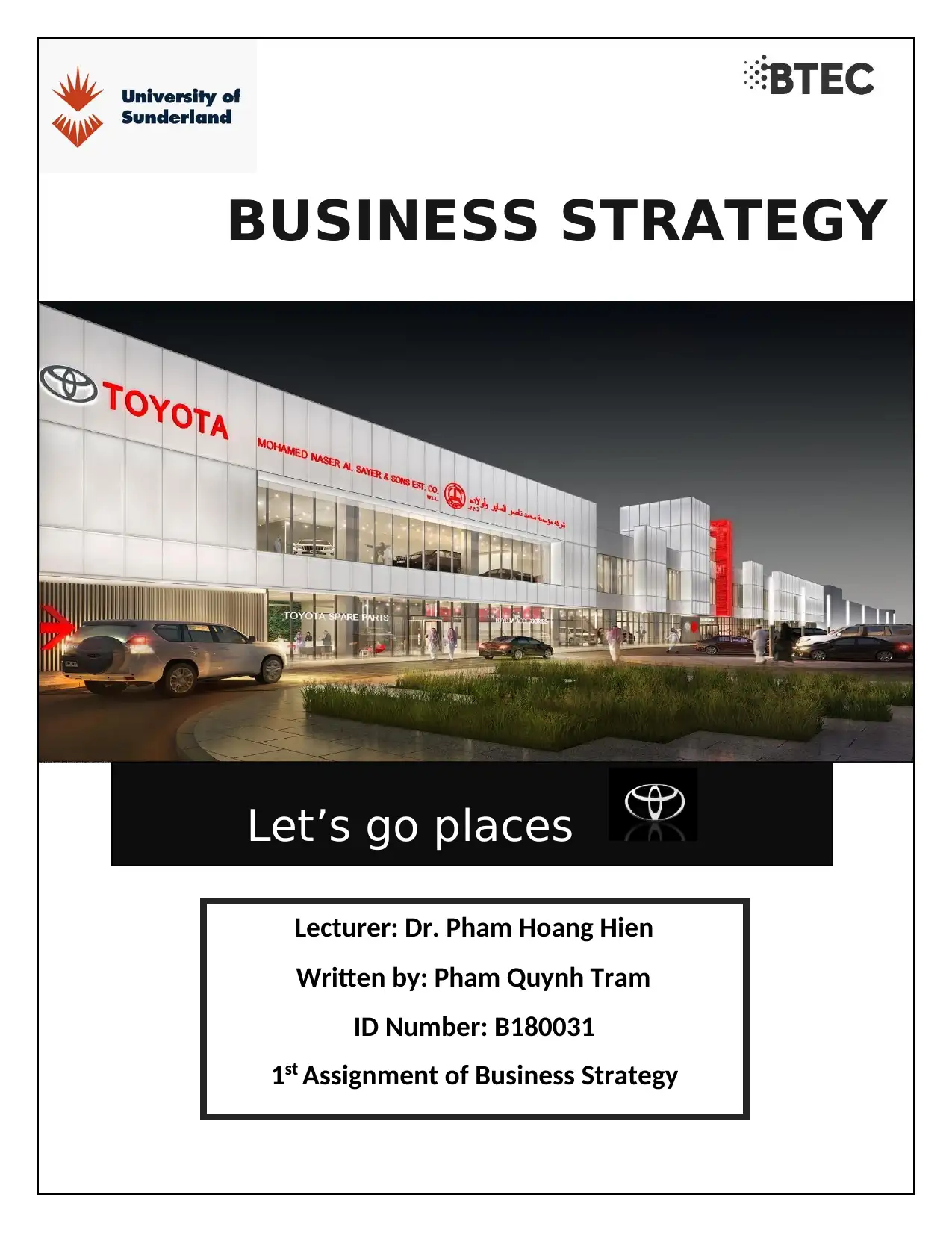
BUSINESS STRATEGY
Lecturer: Dr. Pham Hoang Hien
Written by: Pham Quynh Tram
ID Number: B180031
1st Assignment of Business Strategy
Let’s go places
Lecturer: Dr. Pham Hoang Hien
Written by: Pham Quynh Tram
ID Number: B180031
1st Assignment of Business Strategy
Let’s go places
Paraphrase This Document
Need a fresh take? Get an instant paraphrase of this document with our AI Paraphraser
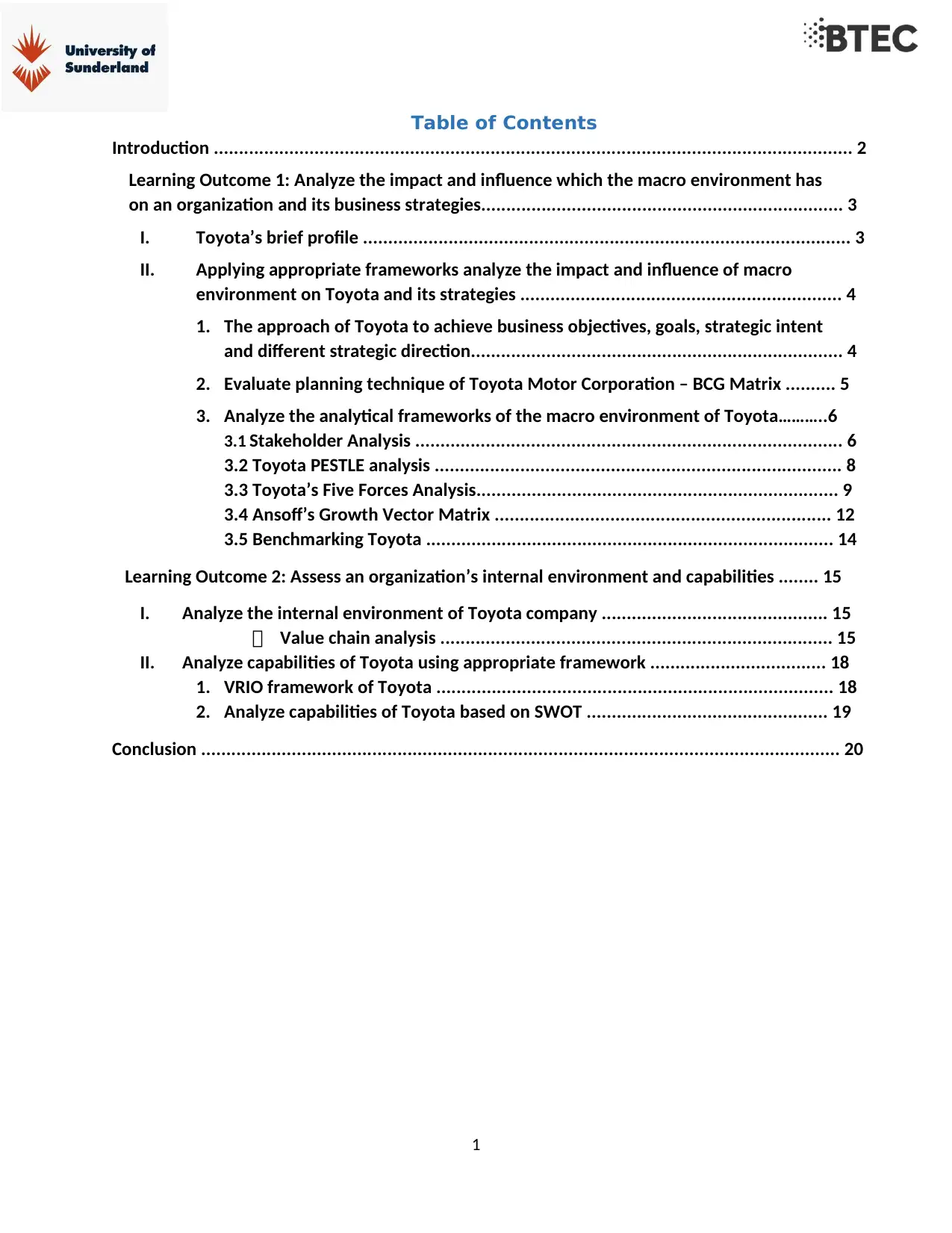
1
Table of Contents
Introduction ............................................................................................................................... 2
Learning Outcome 1: Analyze the impact and influence which the macro environment has
on an organization and its business strategies........................................................................ 3
I. Toyota’s brief profile ................................................................................................. 3
II. Applying appropriate frameworks analyze the impact and influence of macro
environment on Toyota and its strategies ................................................................ 4
1. The approach of Toyota to achieve business objectives, goals, strategic intent
and different strategic direction.......................................................................... 4
2. Evaluate planning technique of Toyota Motor Corporation – BCG Matrix .......... 5
3. Analyze the analytical frameworks of the macro environment of Toyota………..6
3.1 Stakeholder Analysis ..................................................................................... 6
3.2 Toyota PESTLE analysis ................................................................................. 8
3.3 Toyota’s Five Forces Analysis........................................................................ 9
3.4 Ansoff’s Growth Vector Matrix ................................................................... 12
3.5 Benchmarking Toyota ................................................................................. 14
Learning Outcome 2: Assess an organization’s internal environment and capabilities ........ 15
I. Analyze the internal environment of Toyota company ............................................. 15
Value chain analysis .............................................................................. 15
II. Analyze capabilities of Toyota using appropriate framework ................................... 18
1. VRIO framework of Toyota ............................................................................... 18
2. Analyze capabilities of Toyota based on SWOT ................................................ 19
Conclusion ............................................................................................................................... 20
Table of Contents
Introduction ............................................................................................................................... 2
Learning Outcome 1: Analyze the impact and influence which the macro environment has
on an organization and its business strategies........................................................................ 3
I. Toyota’s brief profile ................................................................................................. 3
II. Applying appropriate frameworks analyze the impact and influence of macro
environment on Toyota and its strategies ................................................................ 4
1. The approach of Toyota to achieve business objectives, goals, strategic intent
and different strategic direction.......................................................................... 4
2. Evaluate planning technique of Toyota Motor Corporation – BCG Matrix .......... 5
3. Analyze the analytical frameworks of the macro environment of Toyota………..6
3.1 Stakeholder Analysis ..................................................................................... 6
3.2 Toyota PESTLE analysis ................................................................................. 8
3.3 Toyota’s Five Forces Analysis........................................................................ 9
3.4 Ansoff’s Growth Vector Matrix ................................................................... 12
3.5 Benchmarking Toyota ................................................................................. 14
Learning Outcome 2: Assess an organization’s internal environment and capabilities ........ 15
I. Analyze the internal environment of Toyota company ............................................. 15
Value chain analysis .............................................................................. 15
II. Analyze capabilities of Toyota using appropriate framework ................................... 18
1. VRIO framework of Toyota ............................................................................... 18
2. Analyze capabilities of Toyota based on SWOT ................................................ 19
Conclusion ............................................................................................................................... 20
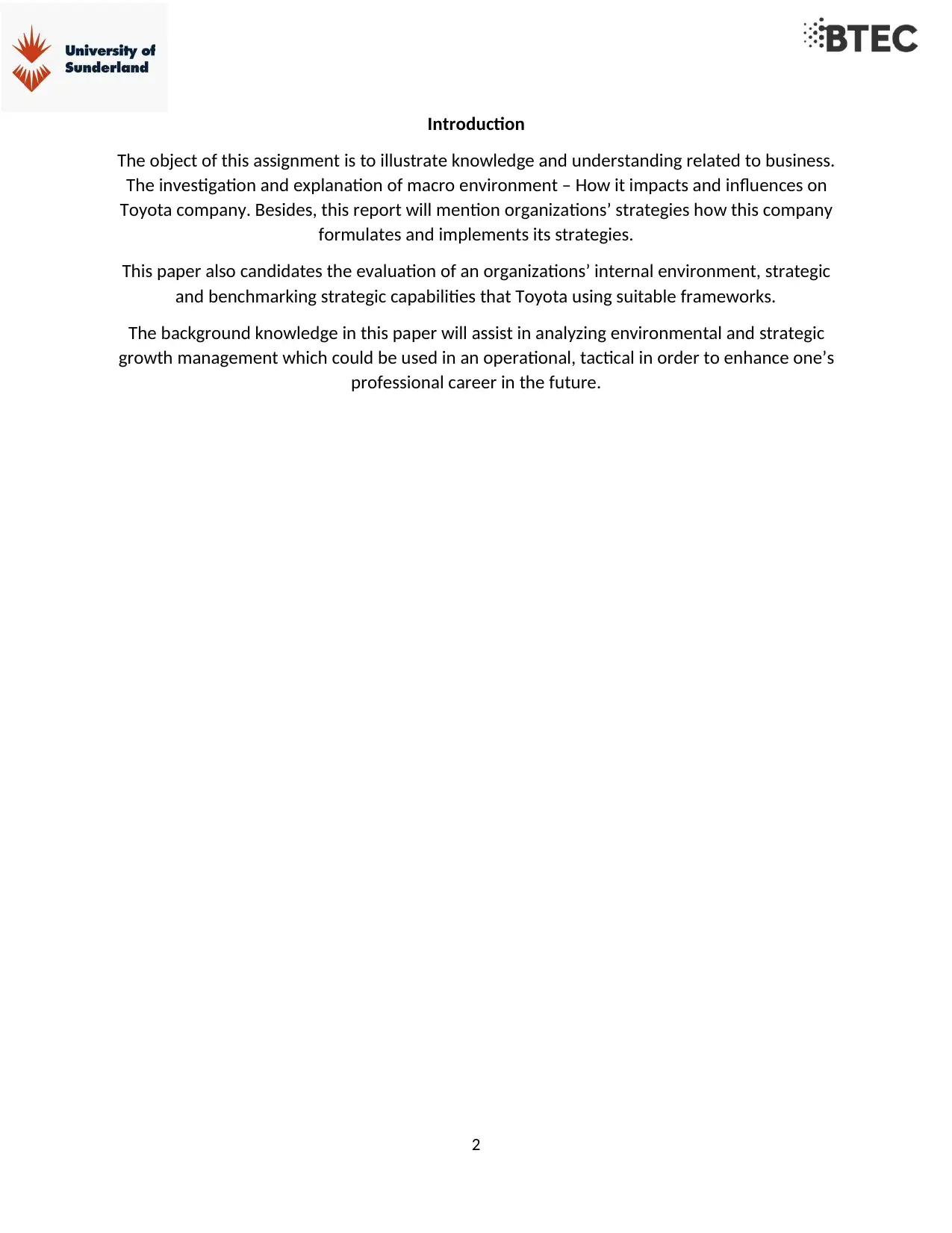
2
Introduction
The object of this assignment is to illustrate knowledge and understanding related to business.
The investigation and explanation of macro environment – How it impacts and influences on
Toyota company. Besides, this report will mention organizations’ strategies how this company
formulates and implements its strategies.
This paper also candidates the evaluation of an organizations’ internal environment, strategic
and benchmarking strategic capabilities that Toyota using suitable frameworks.
The background knowledge in this paper will assist in analyzing environmental and strategic
growth management which could be used in an operational, tactical in order to enhance one’s
professional career in the future.
Introduction
The object of this assignment is to illustrate knowledge and understanding related to business.
The investigation and explanation of macro environment – How it impacts and influences on
Toyota company. Besides, this report will mention organizations’ strategies how this company
formulates and implements its strategies.
This paper also candidates the evaluation of an organizations’ internal environment, strategic
and benchmarking strategic capabilities that Toyota using suitable frameworks.
The background knowledge in this paper will assist in analyzing environmental and strategic
growth management which could be used in an operational, tactical in order to enhance one’s
professional career in the future.
⊘ This is a preview!⊘
Do you want full access?
Subscribe today to unlock all pages.

Trusted by 1+ million students worldwide
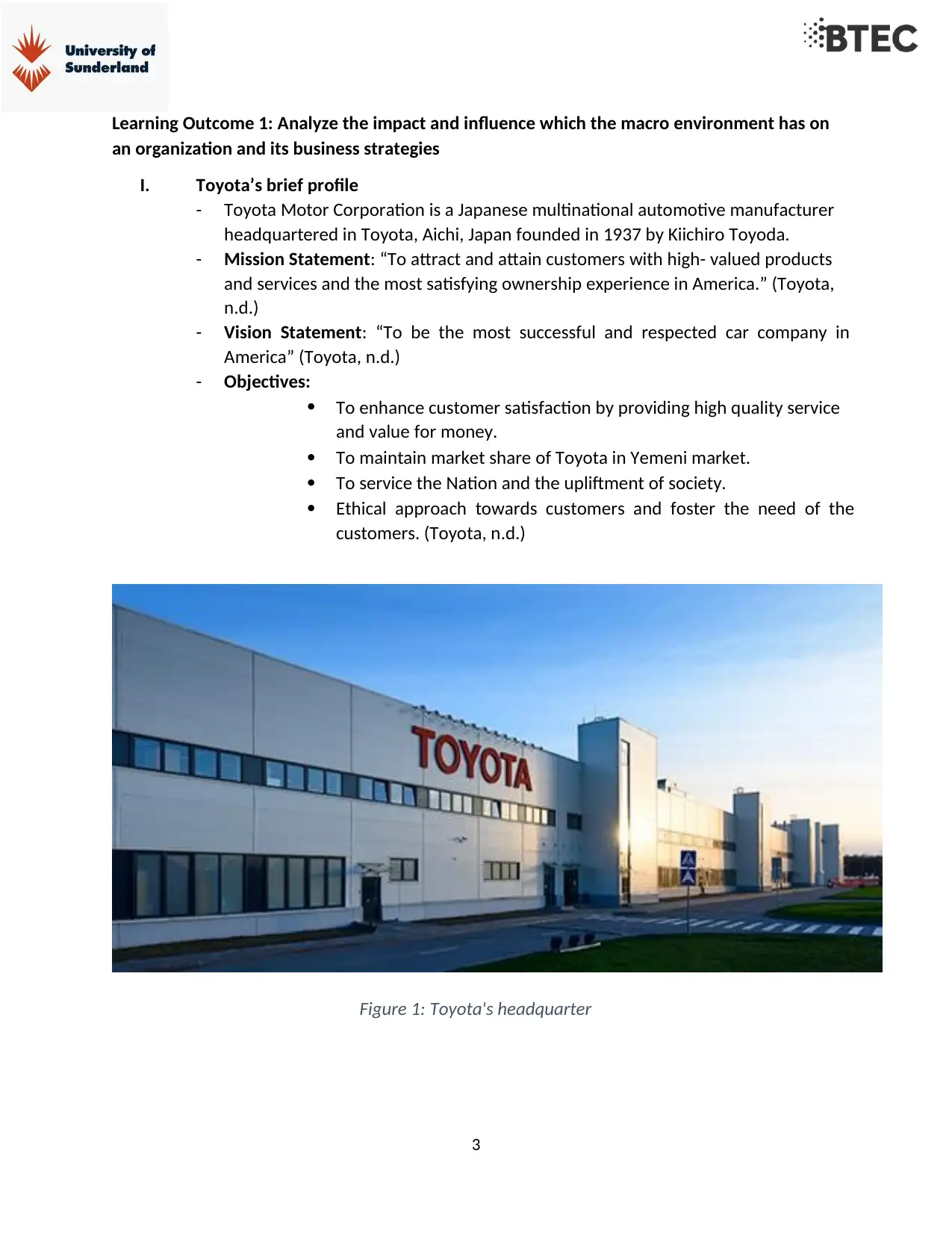
3
Learning Outcome 1: Analyze the impact and influence which the macro environment has on
an organization and its business strategies
I. Toyota’s brief profile
- Toyota Motor Corporation is a Japanese multinational automotive manufacturer
headquartered in Toyota, Aichi, Japan founded in 1937 by Kiichiro Toyoda.
- Mission Statement: “To attract and attain customers with high- valued products
and services and the most satisfying ownership experience in America.” (Toyota,
n.d.)
- Vision Statement: “To be the most successful and respected car company in
America” (Toyota, n.d.)
- Objectives:
To enhance customer satisfaction by providing high quality service
and value for money.
To maintain market share of Toyota in Yemeni market.
To service the Nation and the upliftment of society.
Ethical approach towards customers and foster the need of the
customers. (Toyota, n.d.)
Figure 1: Toyota's headquarter
Learning Outcome 1: Analyze the impact and influence which the macro environment has on
an organization and its business strategies
I. Toyota’s brief profile
- Toyota Motor Corporation is a Japanese multinational automotive manufacturer
headquartered in Toyota, Aichi, Japan founded in 1937 by Kiichiro Toyoda.
- Mission Statement: “To attract and attain customers with high- valued products
and services and the most satisfying ownership experience in America.” (Toyota,
n.d.)
- Vision Statement: “To be the most successful and respected car company in
America” (Toyota, n.d.)
- Objectives:
To enhance customer satisfaction by providing high quality service
and value for money.
To maintain market share of Toyota in Yemeni market.
To service the Nation and the upliftment of society.
Ethical approach towards customers and foster the need of the
customers. (Toyota, n.d.)
Figure 1: Toyota's headquarter
Paraphrase This Document
Need a fresh take? Get an instant paraphrase of this document with our AI Paraphraser
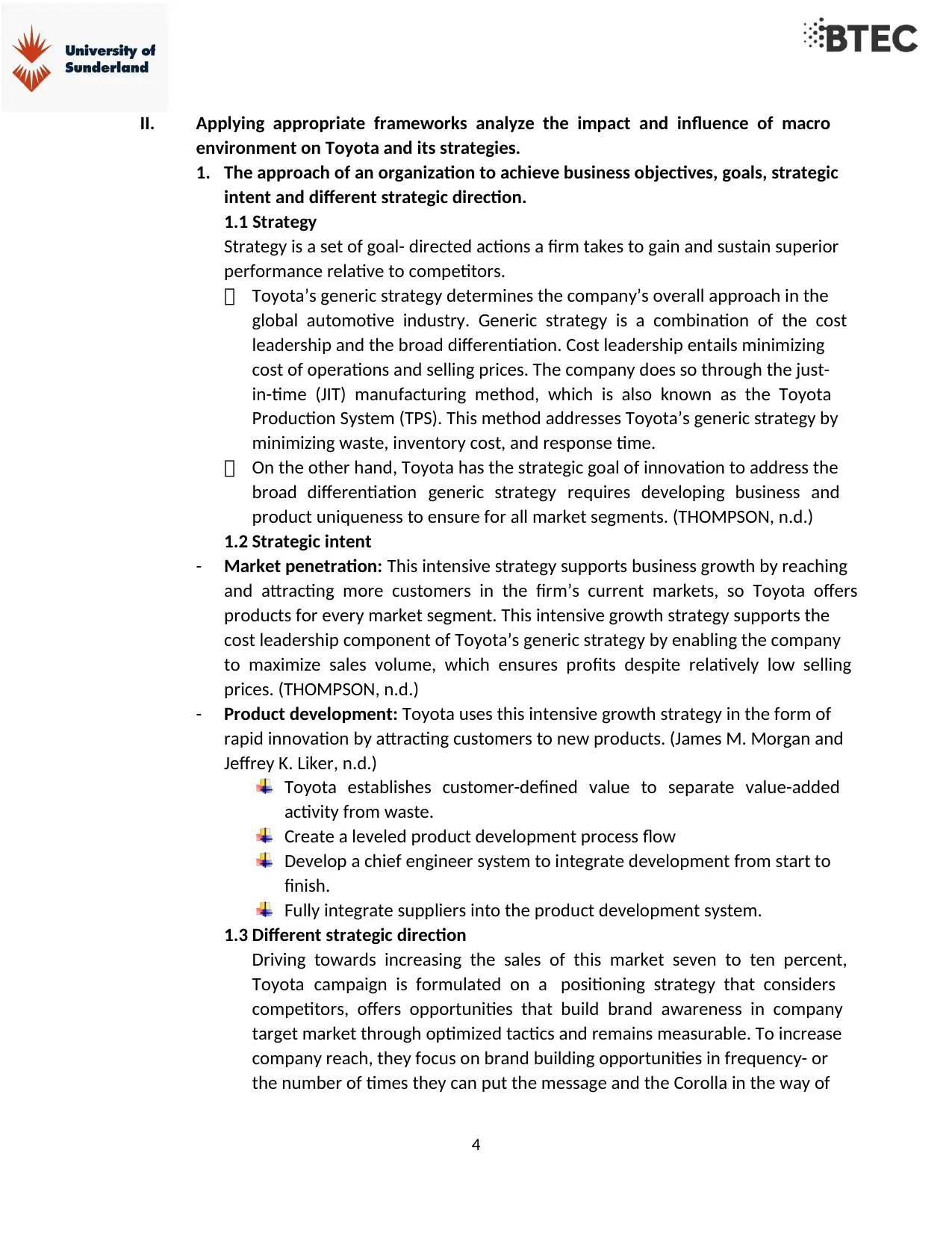
4
II. Applying appropriate frameworks analyze the impact and influence of macro
environment on Toyota and its strategies.
1. The approach of an organization to achieve business objectives, goals, strategic
intent and different strategic direction.
1.1 Strategy
Strategy is a set of goal- directed actions a firm takes to gain and sustain superior
performance relative to competitors.
Toyota’s generic strategy determines the company’s overall approach in the
global automotive industry. Generic strategy is a combination of the cost
leadership and the broad differentiation. Cost leadership entails minimizing
cost of operations and selling prices. The company does so through the just-
in-time (JIT) manufacturing method, which is also known as the Toyota
Production System (TPS). This method addresses Toyota’s generic strategy by
minimizing waste, inventory cost, and response time.
On the other hand, Toyota has the strategic goal of innovation to address the
broad differentiation generic strategy requires developing business and
product uniqueness to ensure for all market segments. (THOMPSON, n.d.)
1.2 Strategic intent
- Market penetration: This intensive strategy supports business growth by reaching
and attracting more customers in the firm’s current markets, so Toyota offers
products for every market segment. This intensive growth strategy supports the
cost leadership component of Toyota’s generic strategy by enabling the company
to maximize sales volume, which ensures profits despite relatively low selling
prices. (THOMPSON, n.d.)
- Product development: Toyota uses this intensive growth strategy in the form of
rapid innovation by attracting customers to new products. (James M. Morgan and
Jeffrey K. Liker, n.d.)
Toyota establishes customer-defined value to separate value-added
activity from waste.
Create a leveled product development process flow
Develop a chief engineer system to integrate development from start to
finish.
Fully integrate suppliers into the product development system.
1.3 Different strategic direction
Driving towards increasing the sales of this market seven to ten percent,
Toyota campaign is formulated on a positioning strategy that considers
competitors, offers opportunities that build brand awareness in company
target market through optimized tactics and remains measurable. To increase
company reach, they focus on brand building opportunities in frequency- or
the number of times they can put the message and the Corolla in the way of
II. Applying appropriate frameworks analyze the impact and influence of macro
environment on Toyota and its strategies.
1. The approach of an organization to achieve business objectives, goals, strategic
intent and different strategic direction.
1.1 Strategy
Strategy is a set of goal- directed actions a firm takes to gain and sustain superior
performance relative to competitors.
Toyota’s generic strategy determines the company’s overall approach in the
global automotive industry. Generic strategy is a combination of the cost
leadership and the broad differentiation. Cost leadership entails minimizing
cost of operations and selling prices. The company does so through the just-
in-time (JIT) manufacturing method, which is also known as the Toyota
Production System (TPS). This method addresses Toyota’s generic strategy by
minimizing waste, inventory cost, and response time.
On the other hand, Toyota has the strategic goal of innovation to address the
broad differentiation generic strategy requires developing business and
product uniqueness to ensure for all market segments. (THOMPSON, n.d.)
1.2 Strategic intent
- Market penetration: This intensive strategy supports business growth by reaching
and attracting more customers in the firm’s current markets, so Toyota offers
products for every market segment. This intensive growth strategy supports the
cost leadership component of Toyota’s generic strategy by enabling the company
to maximize sales volume, which ensures profits despite relatively low selling
prices. (THOMPSON, n.d.)
- Product development: Toyota uses this intensive growth strategy in the form of
rapid innovation by attracting customers to new products. (James M. Morgan and
Jeffrey K. Liker, n.d.)
Toyota establishes customer-defined value to separate value-added
activity from waste.
Create a leveled product development process flow
Develop a chief engineer system to integrate development from start to
finish.
Fully integrate suppliers into the product development system.
1.3 Different strategic direction
Driving towards increasing the sales of this market seven to ten percent,
Toyota campaign is formulated on a positioning strategy that considers
competitors, offers opportunities that build brand awareness in company
target market through optimized tactics and remains measurable. To increase
company reach, they focus on brand building opportunities in frequency- or
the number of times they can put the message and the Corolla in the way of
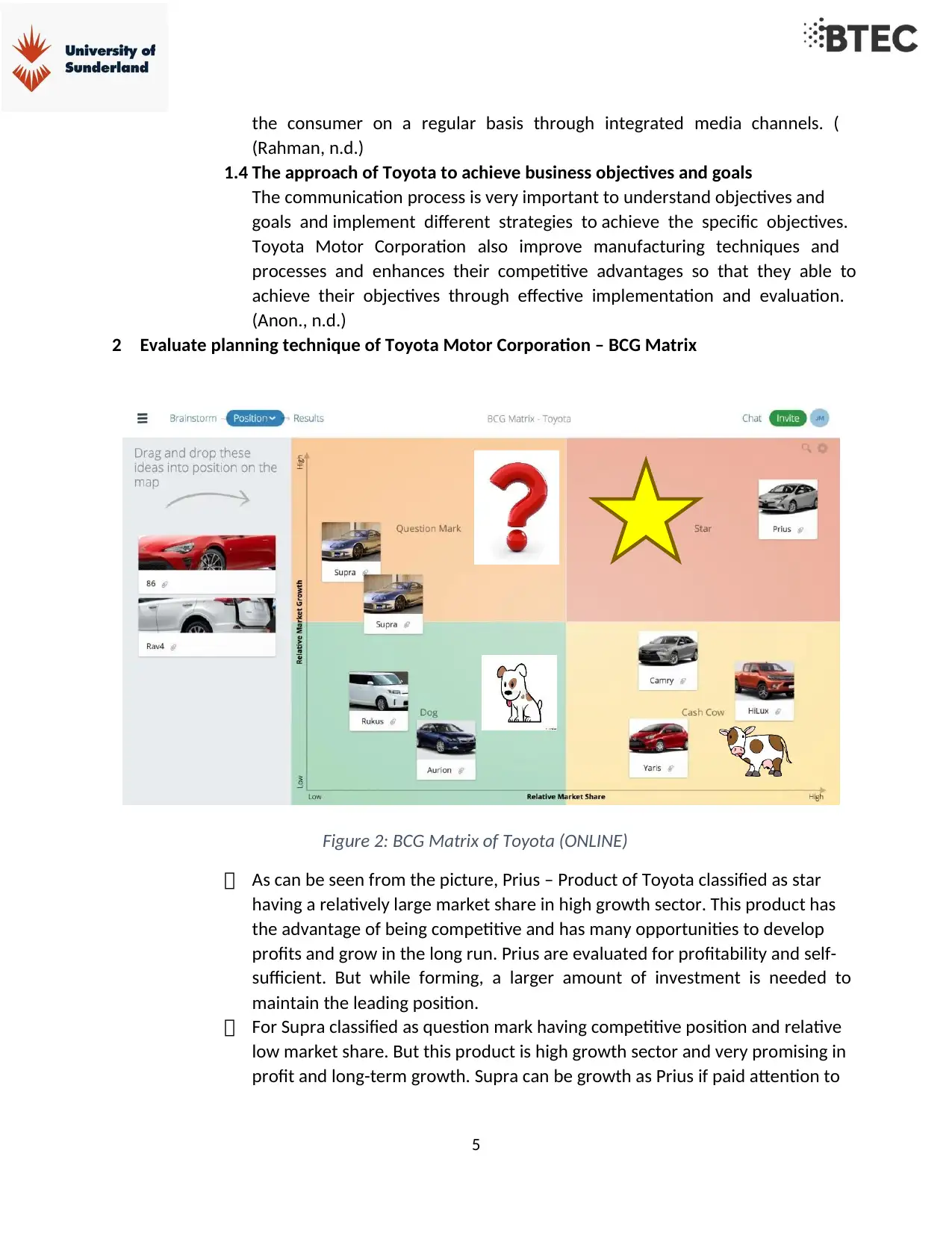
5
the consumer on a regular basis through integrated media channels. (
(Rahman, n.d.)
1.4 The approach of Toyota to achieve business objectives and goals
The communication process is very important to understand objectives and
goals and implement different strategies to achieve the specific objectives.
Toyota Motor Corporation also improve manufacturing techniques and
processes and enhances their competitive advantages so that they able to
achieve their objectives through effective implementation and evaluation.
(Anon., n.d.)
2 Evaluate planning technique of Toyota Motor Corporation – BCG Matrix
Figure 2: BCG Matrix of Toyota (ONLINE)
As can be seen from the picture, Prius – Product of Toyota classified as star
having a relatively large market share in high growth sector. This product has
the advantage of being competitive and has many opportunities to develop
profits and grow in the long run. Prius are evaluated for profitability and self-
sufficient. But while forming, a larger amount of investment is needed to
maintain the leading position.
For Supra classified as question mark having competitive position and relative
low market share. But this product is high growth sector and very promising in
profit and long-term growth. Supra can be growth as Prius if paid attention to
the consumer on a regular basis through integrated media channels. (
(Rahman, n.d.)
1.4 The approach of Toyota to achieve business objectives and goals
The communication process is very important to understand objectives and
goals and implement different strategies to achieve the specific objectives.
Toyota Motor Corporation also improve manufacturing techniques and
processes and enhances their competitive advantages so that they able to
achieve their objectives through effective implementation and evaluation.
(Anon., n.d.)
2 Evaluate planning technique of Toyota Motor Corporation – BCG Matrix
Figure 2: BCG Matrix of Toyota (ONLINE)
As can be seen from the picture, Prius – Product of Toyota classified as star
having a relatively large market share in high growth sector. This product has
the advantage of being competitive and has many opportunities to develop
profits and grow in the long run. Prius are evaluated for profitability and self-
sufficient. But while forming, a larger amount of investment is needed to
maintain the leading position.
For Supra classified as question mark having competitive position and relative
low market share. But this product is high growth sector and very promising in
profit and long-term growth. Supra can be growth as Prius if paid attention to
⊘ This is a preview!⊘
Do you want full access?
Subscribe today to unlock all pages.

Trusted by 1+ million students worldwide
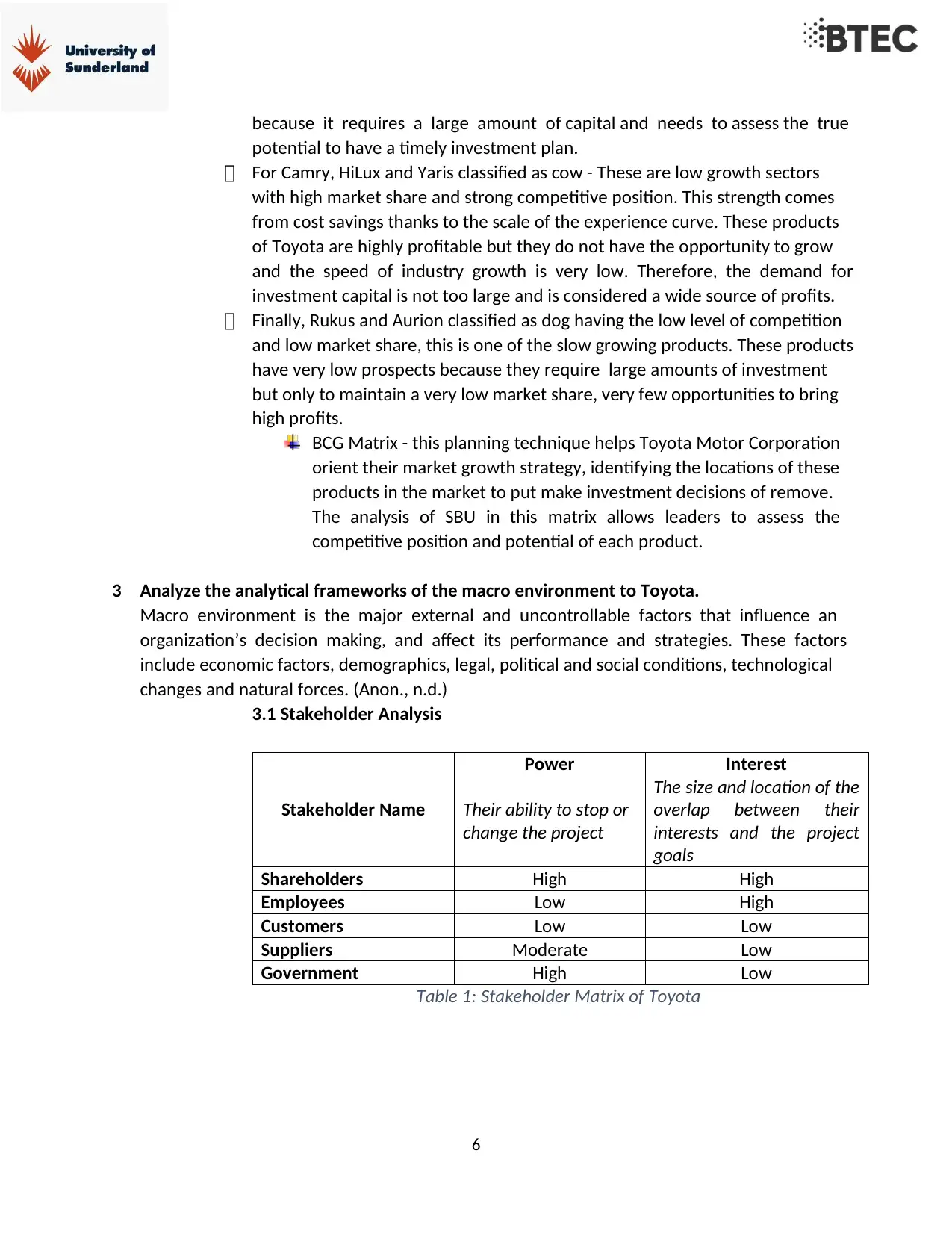
6
because it requires a large amount of capital and needs to assess the true
potential to have a timely investment plan.
For Camry, HiLux and Yaris classified as cow - These are low growth sectors
with high market share and strong competitive position. This strength comes
from cost savings thanks to the scale of the experience curve. These products
of Toyota are highly profitable but they do not have the opportunity to grow
and the speed of industry growth is very low. Therefore, the demand for
investment capital is not too large and is considered a wide source of profits.
Finally, Rukus and Aurion classified as dog having the low level of competition
and low market share, this is one of the slow growing products. These products
have very low prospects because they require large amounts of investment
but only to maintain a very low market share, very few opportunities to bring
high profits.
BCG Matrix - this planning technique helps Toyota Motor Corporation
orient their market growth strategy, identifying the locations of these
products in the market to put make investment decisions of remove.
The analysis of SBU in this matrix allows leaders to assess the
competitive position and potential of each product.
3 Analyze the analytical frameworks of the macro environment to Toyota.
Macro environment is the major external and uncontrollable factors that influence an
organization’s decision making, and affect its performance and strategies. These factors
include economic factors, demographics, legal, political and social conditions, technological
changes and natural forces. (Anon., n.d.)
3.1 Stakeholder Analysis
Stakeholder Name
Power
Their ability to stop or
change the project
Interest
The size and location of the
overlap between their
interests and the project
goals
Shareholders High High
Employees Low High
Customers Low Low
Suppliers Moderate Low
Government High Low
Table 1: Stakeholder Matrix of Toyota
because it requires a large amount of capital and needs to assess the true
potential to have a timely investment plan.
For Camry, HiLux and Yaris classified as cow - These are low growth sectors
with high market share and strong competitive position. This strength comes
from cost savings thanks to the scale of the experience curve. These products
of Toyota are highly profitable but they do not have the opportunity to grow
and the speed of industry growth is very low. Therefore, the demand for
investment capital is not too large and is considered a wide source of profits.
Finally, Rukus and Aurion classified as dog having the low level of competition
and low market share, this is one of the slow growing products. These products
have very low prospects because they require large amounts of investment
but only to maintain a very low market share, very few opportunities to bring
high profits.
BCG Matrix - this planning technique helps Toyota Motor Corporation
orient their market growth strategy, identifying the locations of these
products in the market to put make investment decisions of remove.
The analysis of SBU in this matrix allows leaders to assess the
competitive position and potential of each product.
3 Analyze the analytical frameworks of the macro environment to Toyota.
Macro environment is the major external and uncontrollable factors that influence an
organization’s decision making, and affect its performance and strategies. These factors
include economic factors, demographics, legal, political and social conditions, technological
changes and natural forces. (Anon., n.d.)
3.1 Stakeholder Analysis
Stakeholder Name
Power
Their ability to stop or
change the project
Interest
The size and location of the
overlap between their
interests and the project
goals
Shareholders High High
Employees Low High
Customers Low Low
Suppliers Moderate Low
Government High Low
Table 1: Stakeholder Matrix of Toyota
Paraphrase This Document
Need a fresh take? Get an instant paraphrase of this document with our AI Paraphraser
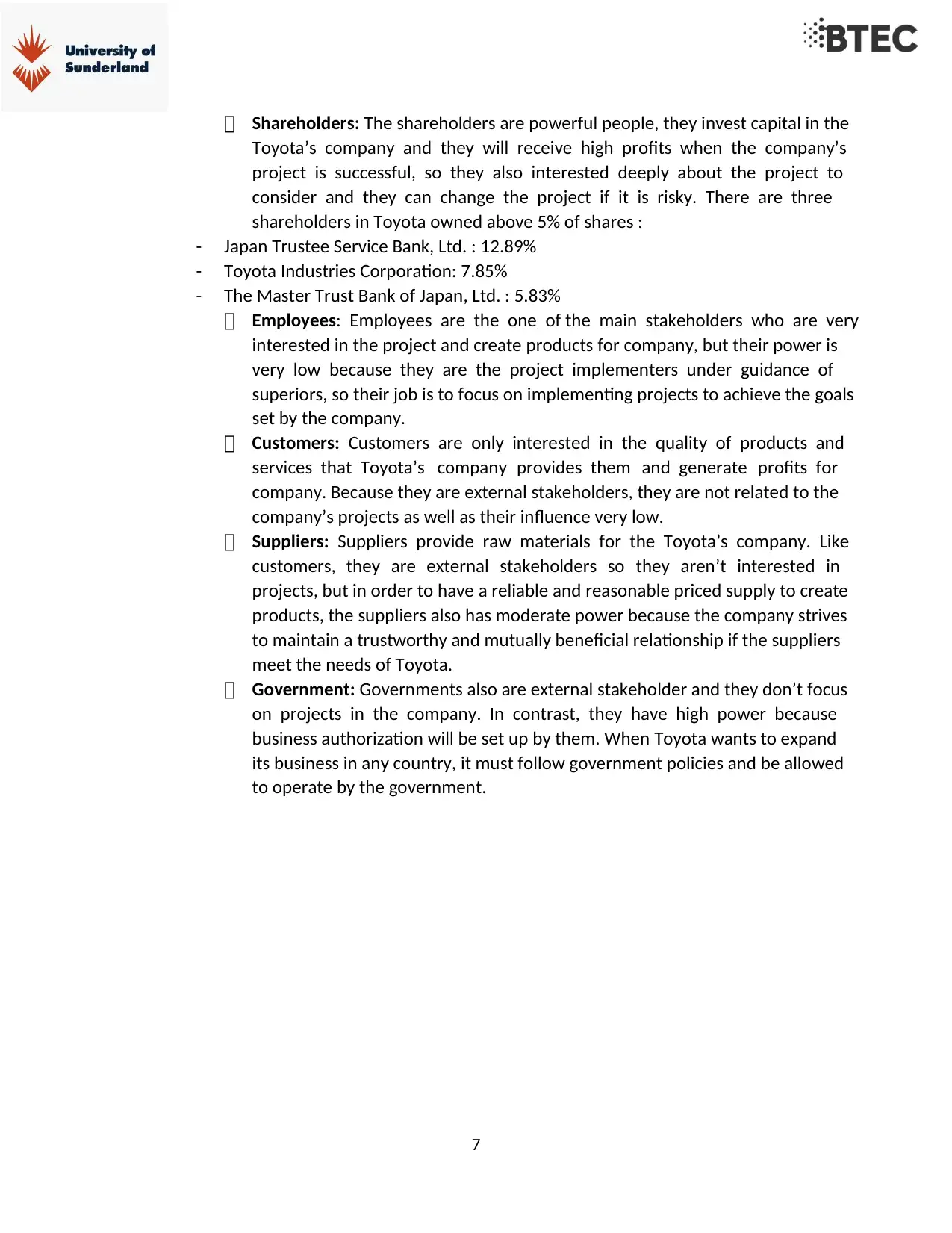
7
Shareholders: The shareholders are powerful people, they invest capital in the
Toyota’s company and they will receive high profits when the company’s
project is successful, so they also interested deeply about the project to
consider and they can change the project if it is risky. There are three
shareholders in Toyota owned above 5% of shares :
- Japan Trustee Service Bank, Ltd. : 12.89%
- Toyota Industries Corporation: 7.85%
- The Master Trust Bank of Japan, Ltd. : 5.83%
Employees: Employees are the one of the main stakeholders who are very
interested in the project and create products for company, but their power is
very low because they are the project implementers under guidance of
superiors, so their job is to focus on implementing projects to achieve the goals
set by the company.
Customers: Customers are only interested in the quality of products and
services that Toyota’s company provides them and generate profits for
company. Because they are external stakeholders, they are not related to the
company’s projects as well as their influence very low.
Suppliers: Suppliers provide raw materials for the Toyota’s company. Like
customers, they are external stakeholders so they aren’t interested in
projects, but in order to have a reliable and reasonable priced supply to create
products, the suppliers also has moderate power because the company strives
to maintain a trustworthy and mutually beneficial relationship if the suppliers
meet the needs of Toyota.
Government: Governments also are external stakeholder and they don’t focus
on projects in the company. In contrast, they have high power because
business authorization will be set up by them. When Toyota wants to expand
its business in any country, it must follow government policies and be allowed
to operate by the government.
Shareholders: The shareholders are powerful people, they invest capital in the
Toyota’s company and they will receive high profits when the company’s
project is successful, so they also interested deeply about the project to
consider and they can change the project if it is risky. There are three
shareholders in Toyota owned above 5% of shares :
- Japan Trustee Service Bank, Ltd. : 12.89%
- Toyota Industries Corporation: 7.85%
- The Master Trust Bank of Japan, Ltd. : 5.83%
Employees: Employees are the one of the main stakeholders who are very
interested in the project and create products for company, but their power is
very low because they are the project implementers under guidance of
superiors, so their job is to focus on implementing projects to achieve the goals
set by the company.
Customers: Customers are only interested in the quality of products and
services that Toyota’s company provides them and generate profits for
company. Because they are external stakeholders, they are not related to the
company’s projects as well as their influence very low.
Suppliers: Suppliers provide raw materials for the Toyota’s company. Like
customers, they are external stakeholders so they aren’t interested in
projects, but in order to have a reliable and reasonable priced supply to create
products, the suppliers also has moderate power because the company strives
to maintain a trustworthy and mutually beneficial relationship if the suppliers
meet the needs of Toyota.
Government: Governments also are external stakeholder and they don’t focus
on projects in the company. In contrast, they have high power because
business authorization will be set up by them. When Toyota wants to expand
its business in any country, it must follow government policies and be allowed
to operate by the government.
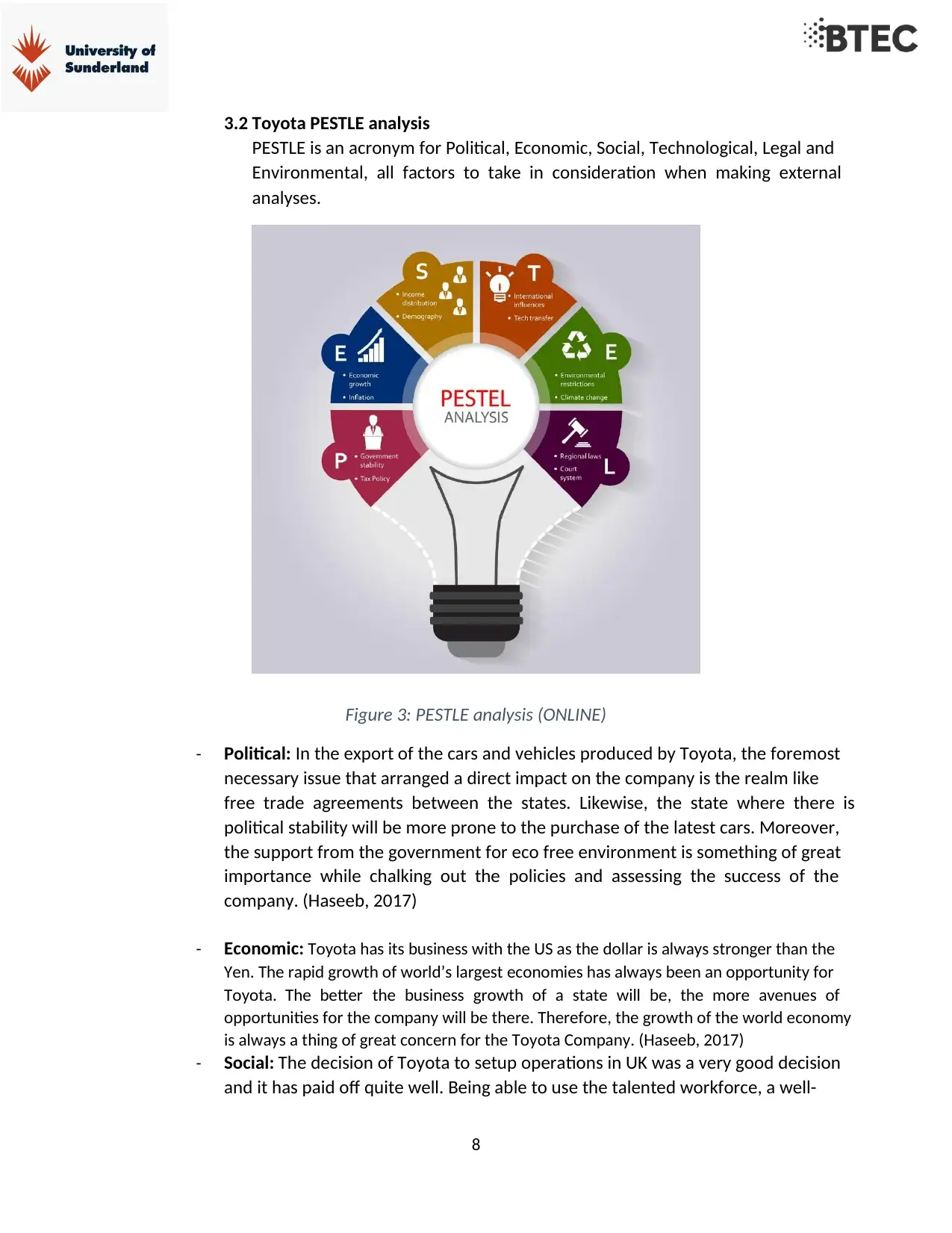
8
3.2 Toyota PESTLE analysis
PESTLE is an acronym for Political, Economic, Social, Technological, Legal and
Environmental, all factors to take in consideration when making external
analyses.
Figure 3: PESTLE analysis (ONLINE)
- Political: In the export of the cars and vehicles produced by Toyota, the foremost
necessary issue that arranged a direct impact on the company is the realm like
free trade agreements between the states. Likewise, the state where there is
political stability will be more prone to the purchase of the latest cars. Moreover,
the support from the government for eco free environment is something of great
importance while chalking out the policies and assessing the success of the
company. (Haseeb, 2017)
- Economic: Toyota has its business with the US as the dollar is always stronger than the
Yen. The rapid growth of world’s largest economies has always been an opportunity for
Toyota. The better the business growth of a state will be, the more avenues of
opportunities for the company will be there. Therefore, the growth of the world economy
is always a thing of great concern for the Toyota Company. (Haseeb, 2017)
- Social: The decision of Toyota to setup operations in UK was a very good decision
and it has paid off quite well. Being able to use the talented workforce, a well-
3.2 Toyota PESTLE analysis
PESTLE is an acronym for Political, Economic, Social, Technological, Legal and
Environmental, all factors to take in consideration when making external
analyses.
Figure 3: PESTLE analysis (ONLINE)
- Political: In the export of the cars and vehicles produced by Toyota, the foremost
necessary issue that arranged a direct impact on the company is the realm like
free trade agreements between the states. Likewise, the state where there is
political stability will be more prone to the purchase of the latest cars. Moreover,
the support from the government for eco free environment is something of great
importance while chalking out the policies and assessing the success of the
company. (Haseeb, 2017)
- Economic: Toyota has its business with the US as the dollar is always stronger than the
Yen. The rapid growth of world’s largest economies has always been an opportunity for
Toyota. The better the business growth of a state will be, the more avenues of
opportunities for the company will be there. Therefore, the growth of the world economy
is always a thing of great concern for the Toyota Company. (Haseeb, 2017)
- Social: The decision of Toyota to setup operations in UK was a very good decision
and it has paid off quite well. Being able to use the talented workforce, a well-
⊘ This is a preview!⊘
Do you want full access?
Subscribe today to unlock all pages.

Trusted by 1+ million students worldwide
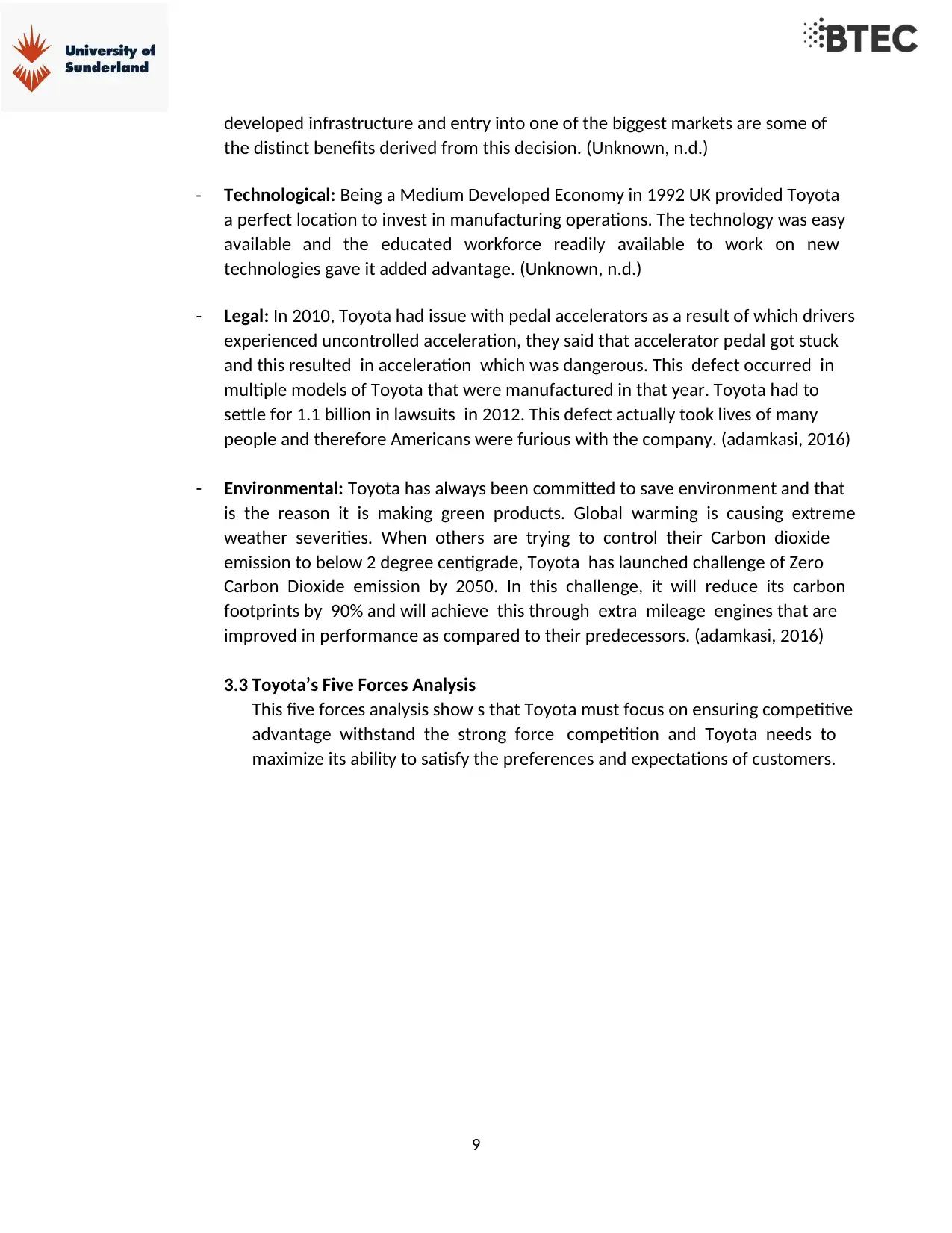
9
developed infrastructure and entry into one of the biggest markets are some of
the distinct benefits derived from this decision. (Unknown, n.d.)
- Technological: Being a Medium Developed Economy in 1992 UK provided Toyota
a perfect location to invest in manufacturing operations. The technology was easy
available and the educated workforce readily available to work on new
technologies gave it added advantage. (Unknown, n.d.)
- Legal: In 2010, Toyota had issue with pedal accelerators as a result of which drivers
experienced uncontrolled acceleration, they said that accelerator pedal got stuck
and this resulted in acceleration which was dangerous. This defect occurred in
multiple models of Toyota that were manufactured in that year. Toyota had to
settle for 1.1 billion in lawsuits in 2012. This defect actually took lives of many
people and therefore Americans were furious with the company. (adamkasi, 2016)
- Environmental: Toyota has always been committed to save environment and that
is the reason it is making green products. Global warming is causing extreme
weather severities. When others are trying to control their Carbon dioxide
emission to below 2 degree centigrade, Toyota has launched challenge of Zero
Carbon Dioxide emission by 2050. In this challenge, it will reduce its carbon
footprints by 90% and will achieve this through extra mileage engines that are
improved in performance as compared to their predecessors. (adamkasi, 2016)
3.3 Toyota’s Five Forces Analysis
This five forces analysis show s that Toyota must focus on ensuring competitive
advantage withstand the strong force competition and Toyota needs to
maximize its ability to satisfy the preferences and expectations of customers.
developed infrastructure and entry into one of the biggest markets are some of
the distinct benefits derived from this decision. (Unknown, n.d.)
- Technological: Being a Medium Developed Economy in 1992 UK provided Toyota
a perfect location to invest in manufacturing operations. The technology was easy
available and the educated workforce readily available to work on new
technologies gave it added advantage. (Unknown, n.d.)
- Legal: In 2010, Toyota had issue with pedal accelerators as a result of which drivers
experienced uncontrolled acceleration, they said that accelerator pedal got stuck
and this resulted in acceleration which was dangerous. This defect occurred in
multiple models of Toyota that were manufactured in that year. Toyota had to
settle for 1.1 billion in lawsuits in 2012. This defect actually took lives of many
people and therefore Americans were furious with the company. (adamkasi, 2016)
- Environmental: Toyota has always been committed to save environment and that
is the reason it is making green products. Global warming is causing extreme
weather severities. When others are trying to control their Carbon dioxide
emission to below 2 degree centigrade, Toyota has launched challenge of Zero
Carbon Dioxide emission by 2050. In this challenge, it will reduce its carbon
footprints by 90% and will achieve this through extra mileage engines that are
improved in performance as compared to their predecessors. (adamkasi, 2016)
3.3 Toyota’s Five Forces Analysis
This five forces analysis show s that Toyota must focus on ensuring competitive
advantage withstand the strong force competition and Toyota needs to
maximize its ability to satisfy the preferences and expectations of customers.
Paraphrase This Document
Need a fresh take? Get an instant paraphrase of this document with our AI Paraphraser
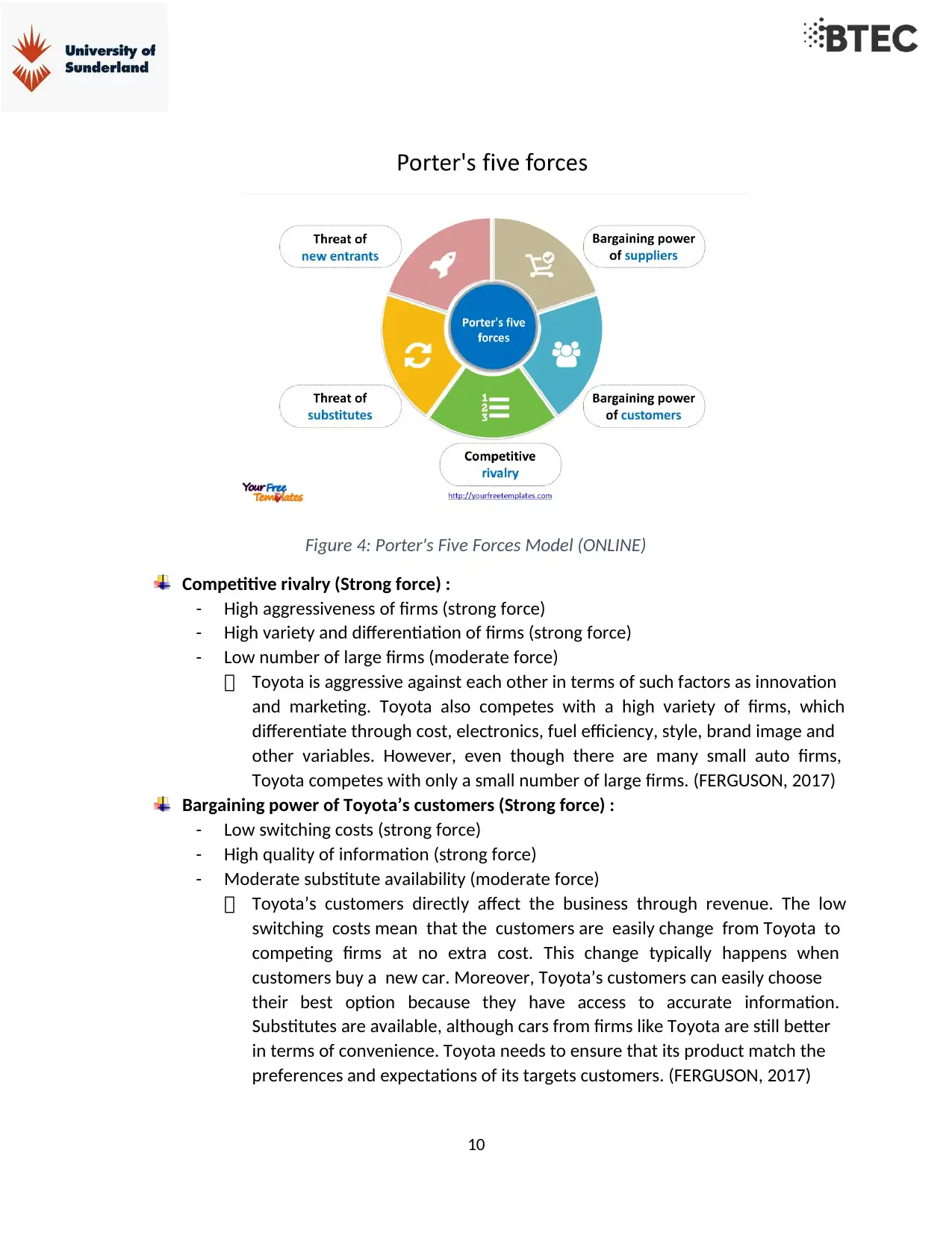
10
Figure 4: Porter's Five Forces Model (ONLINE)
Competitive rivalry (Strong force) :
- High aggressiveness of firms (strong force)
- High variety and differentiation of firms (strong force)
- Low number of large firms (moderate force)
Toyota is aggressive against each other in terms of such factors as innovation
and marketing. Toyota also competes with a high variety of firms, which
differentiate through cost, electronics, fuel efficiency, style, brand image and
other variables. However, even though there are many small auto firms,
Toyota competes with only a small number of large firms. (FERGUSON, 2017)
Bargaining power of Toyota’s customers (Strong force) :
- Low switching costs (strong force)
- High quality of information (strong force)
- Moderate substitute availability (moderate force)
Toyota’s customers directly affect the business through revenue. The low
switching costs mean that the customers are easily change from Toyota to
competing firms at no extra cost. This change typically happens when
customers buy a new car. Moreover, Toyota’s customers can easily choose
their best option because they have access to accurate information.
Substitutes are available, although cars from firms like Toyota are still better
in terms of convenience. Toyota needs to ensure that its product match the
preferences and expectations of its targets customers. (FERGUSON, 2017)
Figure 4: Porter's Five Forces Model (ONLINE)
Competitive rivalry (Strong force) :
- High aggressiveness of firms (strong force)
- High variety and differentiation of firms (strong force)
- Low number of large firms (moderate force)
Toyota is aggressive against each other in terms of such factors as innovation
and marketing. Toyota also competes with a high variety of firms, which
differentiate through cost, electronics, fuel efficiency, style, brand image and
other variables. However, even though there are many small auto firms,
Toyota competes with only a small number of large firms. (FERGUSON, 2017)
Bargaining power of Toyota’s customers (Strong force) :
- Low switching costs (strong force)
- High quality of information (strong force)
- Moderate substitute availability (moderate force)
Toyota’s customers directly affect the business through revenue. The low
switching costs mean that the customers are easily change from Toyota to
competing firms at no extra cost. This change typically happens when
customers buy a new car. Moreover, Toyota’s customers can easily choose
their best option because they have access to accurate information.
Substitutes are available, although cars from firms like Toyota are still better
in terms of convenience. Toyota needs to ensure that its product match the
preferences and expectations of its targets customers. (FERGUSON, 2017)
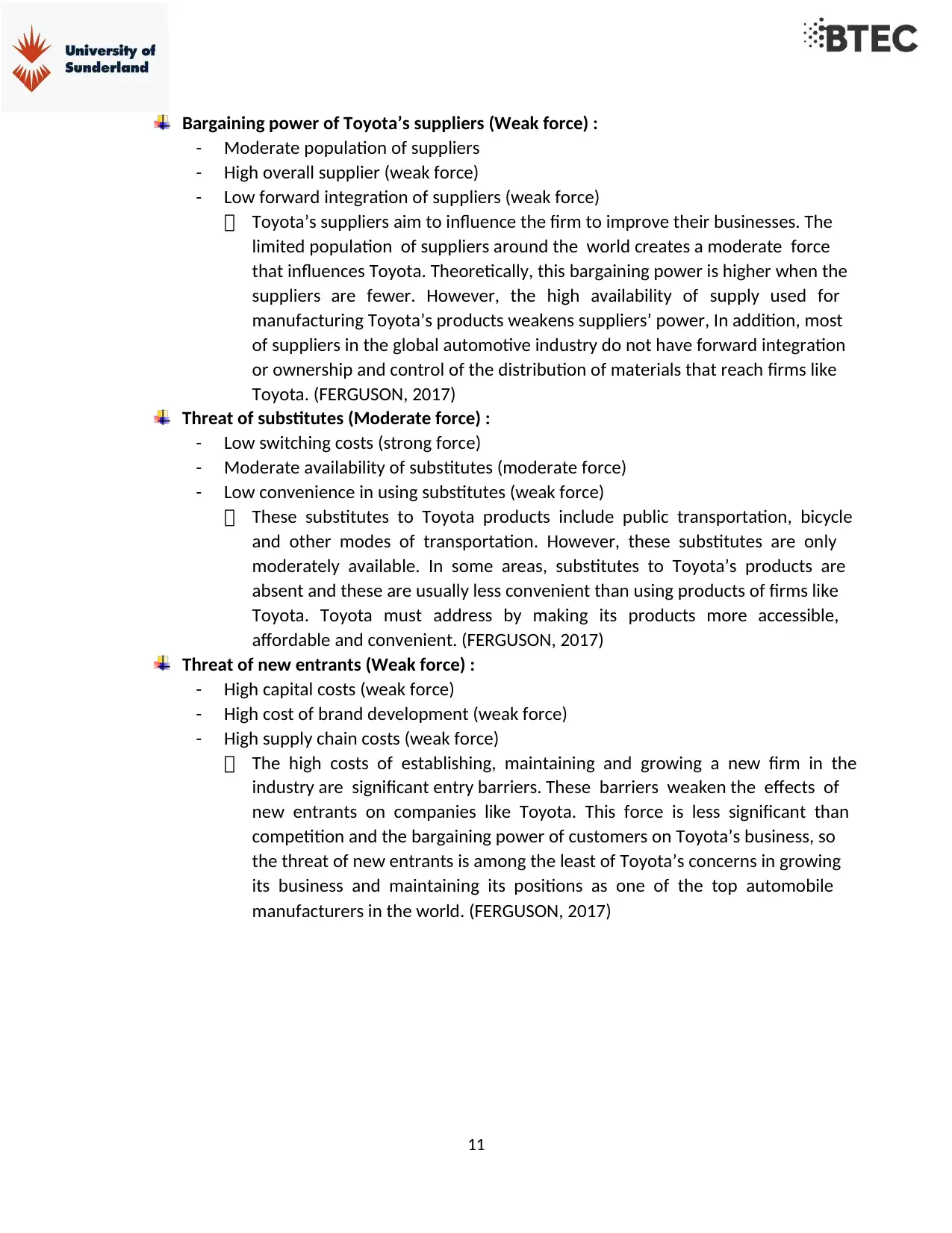
11
Bargaining power of Toyota’s suppliers (Weak force) :
- Moderate population of suppliers
- High overall supplier (weak force)
- Low forward integration of suppliers (weak force)
Toyota’s suppliers aim to influence the firm to improve their businesses. The
limited population of suppliers around the world creates a moderate force
that influences Toyota. Theoretically, this bargaining power is higher when the
suppliers are fewer. However, the high availability of supply used for
manufacturing Toyota’s products weakens suppliers’ power, In addition, most
of suppliers in the global automotive industry do not have forward integration
or ownership and control of the distribution of materials that reach firms like
Toyota. (FERGUSON, 2017)
Threat of substitutes (Moderate force) :
- Low switching costs (strong force)
- Moderate availability of substitutes (moderate force)
- Low convenience in using substitutes (weak force)
These substitutes to Toyota products include public transportation, bicycle
and other modes of transportation. However, these substitutes are only
moderately available. In some areas, substitutes to Toyota’s products are
absent and these are usually less convenient than using products of firms like
Toyota. Toyota must address by making its products more accessible,
affordable and convenient. (FERGUSON, 2017)
Threat of new entrants (Weak force) :
- High capital costs (weak force)
- High cost of brand development (weak force)
- High supply chain costs (weak force)
The high costs of establishing, maintaining and growing a new firm in the
industry are significant entry barriers. These barriers weaken the effects of
new entrants on companies like Toyota. This force is less significant than
competition and the bargaining power of customers on Toyota’s business, so
the threat of new entrants is among the least of Toyota’s concerns in growing
its business and maintaining its positions as one of the top automobile
manufacturers in the world. (FERGUSON, 2017)
Bargaining power of Toyota’s suppliers (Weak force) :
- Moderate population of suppliers
- High overall supplier (weak force)
- Low forward integration of suppliers (weak force)
Toyota’s suppliers aim to influence the firm to improve their businesses. The
limited population of suppliers around the world creates a moderate force
that influences Toyota. Theoretically, this bargaining power is higher when the
suppliers are fewer. However, the high availability of supply used for
manufacturing Toyota’s products weakens suppliers’ power, In addition, most
of suppliers in the global automotive industry do not have forward integration
or ownership and control of the distribution of materials that reach firms like
Toyota. (FERGUSON, 2017)
Threat of substitutes (Moderate force) :
- Low switching costs (strong force)
- Moderate availability of substitutes (moderate force)
- Low convenience in using substitutes (weak force)
These substitutes to Toyota products include public transportation, bicycle
and other modes of transportation. However, these substitutes are only
moderately available. In some areas, substitutes to Toyota’s products are
absent and these are usually less convenient than using products of firms like
Toyota. Toyota must address by making its products more accessible,
affordable and convenient. (FERGUSON, 2017)
Threat of new entrants (Weak force) :
- High capital costs (weak force)
- High cost of brand development (weak force)
- High supply chain costs (weak force)
The high costs of establishing, maintaining and growing a new firm in the
industry are significant entry barriers. These barriers weaken the effects of
new entrants on companies like Toyota. This force is less significant than
competition and the bargaining power of customers on Toyota’s business, so
the threat of new entrants is among the least of Toyota’s concerns in growing
its business and maintaining its positions as one of the top automobile
manufacturers in the world. (FERGUSON, 2017)
⊘ This is a preview!⊘
Do you want full access?
Subscribe today to unlock all pages.

Trusted by 1+ million students worldwide
1 out of 23
Related Documents
Your All-in-One AI-Powered Toolkit for Academic Success.
+13062052269
info@desklib.com
Available 24*7 on WhatsApp / Email
![[object Object]](/_next/static/media/star-bottom.7253800d.svg)
Unlock your academic potential
Copyright © 2020–2025 A2Z Services. All Rights Reserved. Developed and managed by ZUCOL.




